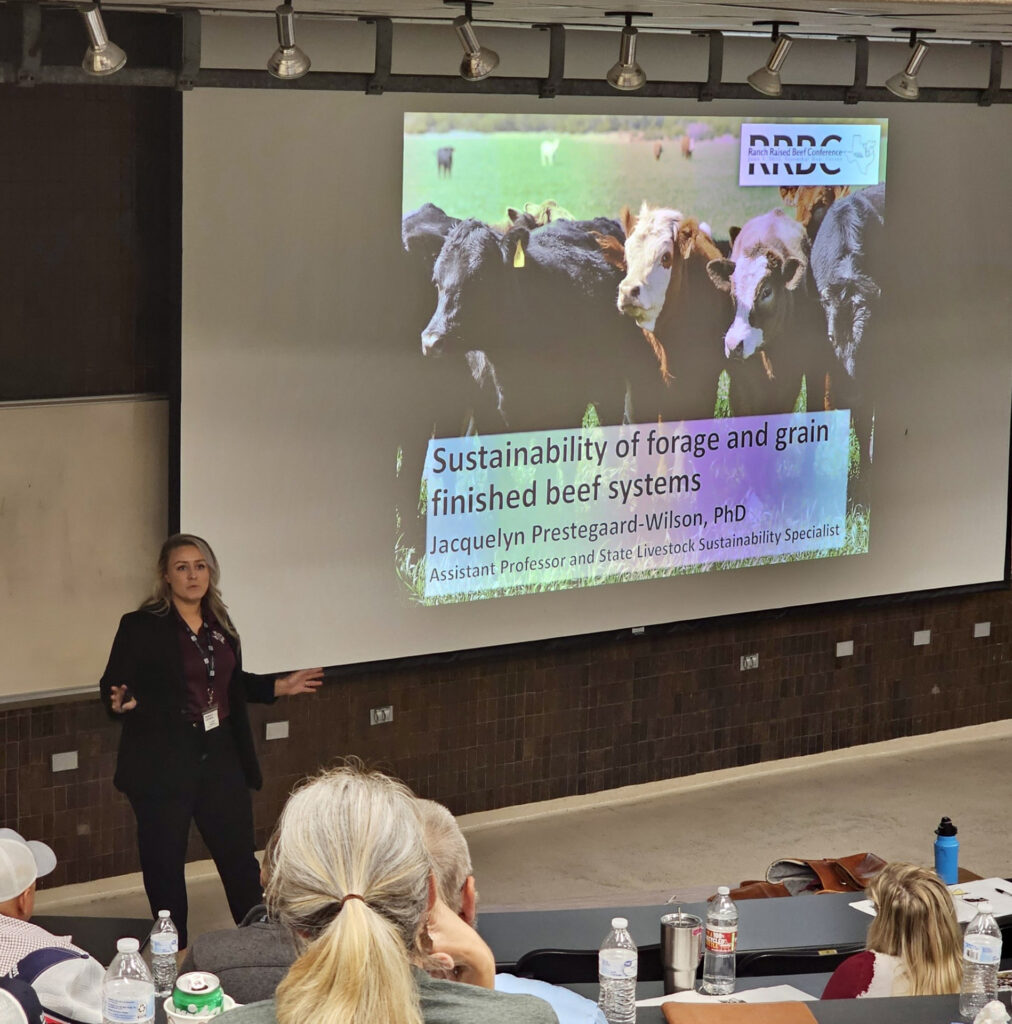Prestegaard-Wilson brings nutrition management to livestock sustainability conversation
AgriLife Extension hires new sustainability specialist in Department of Animal Science
While sustainability may be perceived in different ways, depending on the audience, Jacquelyn Prestegaard-Wilson, Ph.D., is developing an educational campaign to create sustainable livestock systems across Texas.

Prestegaard-Wilson is the statewide Texas A&M AgriLife Extension Service livestock sustainability specialist and an assistant professor in the Texas A&M College of Agriculture and Life Sciences Department of Animal Science, Bryan-College Station.
In her new role, Prestegaard-Wilson said she wants to take what she has learned as a ruminant nutritionist and improve the understanding of the role nutrition plays in establishing sustainable livestock systems.
From nutrient management to sustainability
Prestegaard-Wilson grew up on a small cow-calf operation in Northern Illinois, and when she was headed to the University of Illinois for her undergraduate degree, she decided she wanted to go into ruminant nutrition.
She earned her bachelor’s degree in animal science from the University of Illinois Urbana-Champaign, her master’s in ruminant nutrition from the University of Missouri-Columbia and her doctorate in dairy cattle nutrition from Virginia Tech.
“A lot of how nitrogen and phosphorus end up in manure is related to what you feed the cows,” Prestegaard-Wilson said. “Part of my graduate research involved using machine learning to find a combination of ingredients that were the perfect balance between profitability for the producer and excreting the least amount of pollutants from the manure.”
Economics and environment are two pillars of sustainability, with social being the third pillar, she said.
“That got me to thinking about sustainability, thinking about finding all of that balance and realizing there are pushes and pulls and lots of tradeoffs involved,” she said. “That represents a large opportunity to help producers minimize their feed costs and maximize their outputs, but also minimize their environmental footprint.”
Building an impactful program
As an AgriLife Extension specialist, Prestegaard-Wilson said her current focus is to work directly with county agents and conduct training on proper nutrition management strategies, which are critical for ranchers or beef producers to stay in business.
She’s also developing training and collaborating with range and beef specialists on different grazing management strategies, such as rotational grazing, because properly managing pastures can help their operations become more resilient and sustainable during periods of drought.
“You will never really be able to ‘drought proof’ your property, but you can help seriously mitigate some of the negative consequences, not to mention improve soil health and quality and minimize the need for certain pest management tactics that come along with proper grazing management strategies,” Prestegaard-Wilson said.
Prestegaard-Wilson is building foundational programming, starting with the livestock she knows best, beef and dairy, and then hopes to migrate and work into the swine and sheep industries. For example, integrating sheep and goats into people’s pastureland may help reduce the parasitic load and potentially some brush problems they face.
“I want to develop some nutrition management and forage testing plans for producers and then also work with AgriLife Extension’s family and community health unit to determine what efforts and outcomes are of value to our consumers,” she said.
She hopes to explore answers to questions like what consumers care about when it comes to companies setting sustainability goals. Do they care about company initiatives to have carbon-neutral practices by a certain year? To what degree are consumers willing to pay more for that? What needs to be done to make “environmentally friendly” products more accessible to people across socioeconomic statuses?
Developing a worldview of sustainability
Prestegaard-Wilson said she wants to help producers understand different methods, strategies and technologies to make their operations sustainable and help consumers understand what producers need to run their livestock business in a sensitive environment.
“Sustainability really means something different to everybody,” Prestegaard-Wilson said. “I’ve learned many producers see sustainability as synonymous with stewardship, which means being a steward of both their livestock and the land in a way that they can maintain their operations today and in the future. Many have had the land for multiple generations and want to see it continue.”
Producers face different sorts of daily and future challenges, like climate change and changing animal agriculture rules.
Prestegaard-Wilson said her job is to help them navigate those challenges and also support county agents as they work with producers on those issues.
She explained that consumers and policymakers often think more broadscale with multiple facets. Policymakers or industry groups may discuss carbon markets and climate goals they’re trying to set and meet, which implies they view the definition of sustainability as one that primarily relates to environmental legislation, which discounts downstream economic and social implications for livestock producers.
“It’s interesting to navigate the different viewpoints and answers to ‘what is sustainability,’” Prestegaard-Wilson said. “So, my job starts by listening to everyone’s concerns and understanding their worldview. I try to navigate and liaison those conversations, truly listening and empathizing where they are coming from.”


